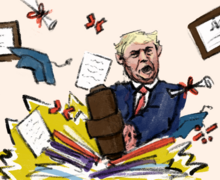McDonell: Cuomo’s child labor law may affect young models, New York Fashion Week
Models are known for their youthful faces and skinny bodies, parading one after the other down the runway. It’s no secret that designers use underage models to keep their shows looking fresh. However, February’s New York Fashion Week might be looking more mature than ever.
In October, Governor Andrew Cuomo passed a law recognizing child models as child performers. The law went into effect in November, but this week’s shows are the first time the law will be tested.
The fashion may be modern, but its policies are playing catch up.
The new law means models under the age of 18 are required to have work permits and a trust fund set up in their name. Clients — in this case, the designers — are required to have a certificate of eligibility to employ child performers.
Designers who violate the law face fines, along with the loss of their certificate of eligibility.
The law also dictates how many hours models can work, how often they can work and how late they can be kept at a job or model casting.
While the new legislation is definitely a step in the right direction for the fashion industry, critics have concerns about its effectiveness. How well will it be enforced? How will the fashion industry be affected? It looks like after this week we will have our answers.
This year’s New York Fashion Week, which runs from Feb. 6 through Feb. 13, is the first to occur under the new law. It seems like the easiest route for designers is just to forgo using any models under the age of 18. They won’t have to fill out the stacks of paperwork or jump through any hoops to get certification. No one wants to see a 16 year-old strutting her stuff down the runway in clothes that shouldn’t be worn until she’s at least 23 anyway.
For the designers who want to continue casting underage girls in their shows, the new law will pose a lot of problems. First, the limited work hours means that models must leave their jobs before midnight during the week and 12:30 a.m. on the weekends, and they must be given 12 hours in between jobs. In years past, models have reported working long, late hours during fashion week.
Just last year, feminist website Jezebel uncovered the Tumblr of a 17-year-old model who described her modeling schedule at NYFW, working more than 30 hours, unpaid, for Marc Jacobs, often until 2 or 4 a.m.
Talk about staying late at work.
The other problem is in paying the models. Because of the trust fund that models are now required to have, the law could indirectly affect the common practice of paying models through trade — giving them clothing for work, rather than money. While I wouldn’t mind being paid in clothes, it’s something that the new law might not allow. Models now have to put a certain percentage of their income into the trust, which you can’t really do with clothes.
The Council of Fashion Designers in America already advises that designers not hire models under 16, but it doesn’t enforce its own guidelines. Just last year, Marc Jacobs received a lot of backlash after he used two models under the age of 16. It’s hard to say how much bad publicity a designer would get if they were found violating the new law.
The new law could certainly be a good thing for the fashion and modeling industries. I think that recently we have seen too many young girls in the business. For older models there was always the pressure to be thin because these girls were so young, and therefore less maturely built. By the time they turned 18, they had the pressure to not lose their pre-pubescent bodies, which brings up the issue of eating disorders with models. It was time that somebody put their foot down and declared: this is not the way this business should be run.
Alexis McDonell is a sophomore magazine journalism major. Her column appears every Monday in Pulp. E-mail her at admcdone@syr.edu and follow her on Twitter at @AlexisMickD.
Published on February 9, 2014 at 10:42 pm





